Menus
- The strongest production two-cylinder in the test
- MOTORCYCLE points evaluation / conclusion
- Technical data / noticed
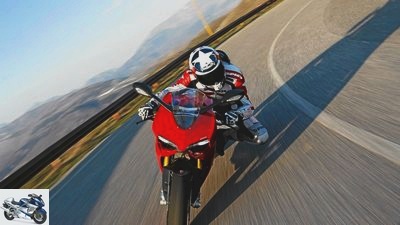
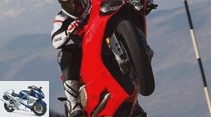
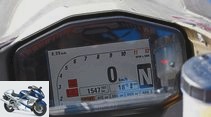
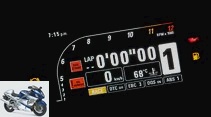
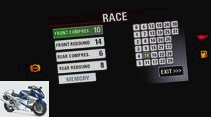
15th photos
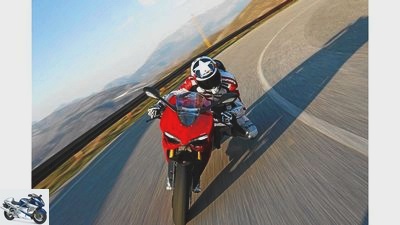
1/15
Grim look: LED headlights are being used for the first time in a motorcycle.
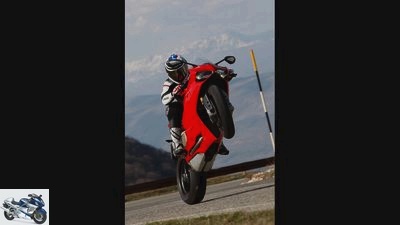
2/15
Ducati 1199 Panigale S Wheelie.
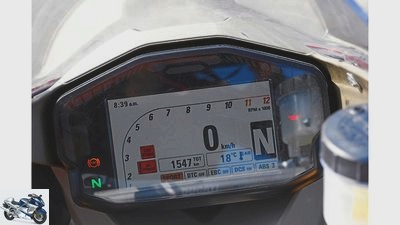
3/15
TFT display with daylight.
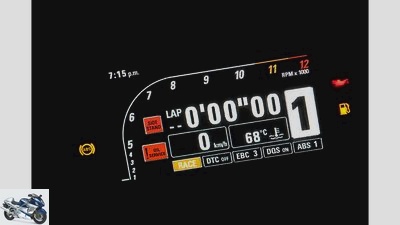
4/15
As soon as it gets dark, the TFT display switches from day to night lighting.
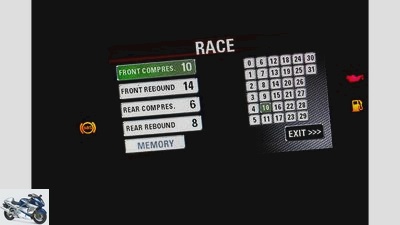
5/15
All settings can be changed individually from the handlebars via a simple menu, here the suspension setup.
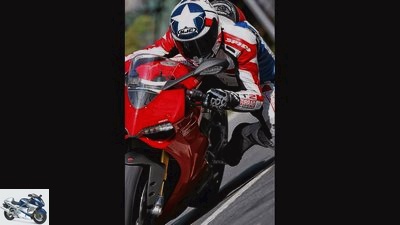
6/15
Ducati Panigale 1199 S..
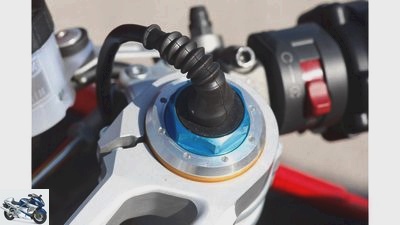
7/15
Electromagnetic valves change the damping in the spring elements. Standard on the Panigale S and S Tricolore.
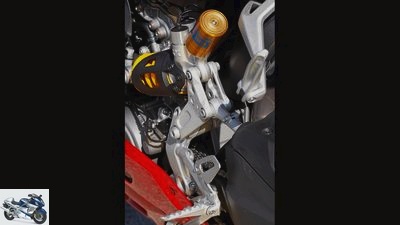
8/15
For two-person operation, the linkage of the push rod and thus the progression can be changed.
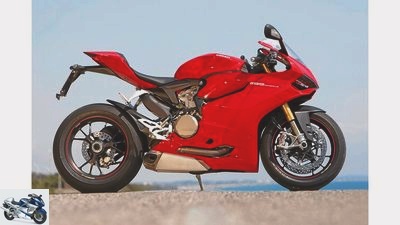
9/15
Ducati 1199 Panigale S..
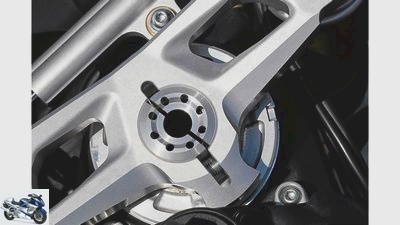
10/15
Huge steering head for rigidity, but without adjustment options for caster and steering head angle as with the 916 and 999.
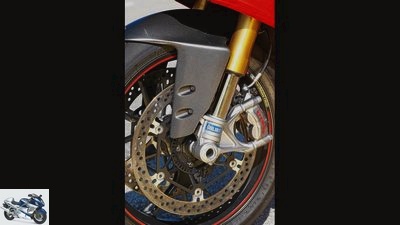
11/15
At least for the time being, the latest generation of Brembo M50 calipers bite into 330 mm discs exclusively in the Panigale.
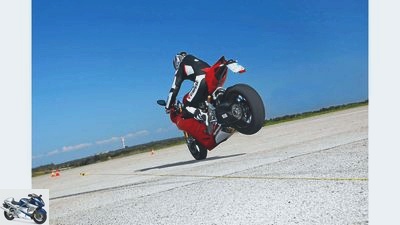
12/15
The Panigale enables front wheel dancing especially in race mode, but this also results in very short braking distances.
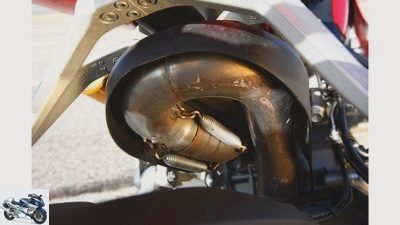
13/15
The line of elbows of the standing cylinder heats up the thighs strongly, especially uncomfortable in the city.
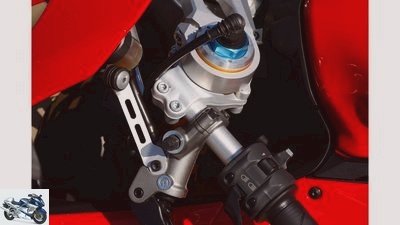
14/15
The steering angle allows an acceptable turning circle.
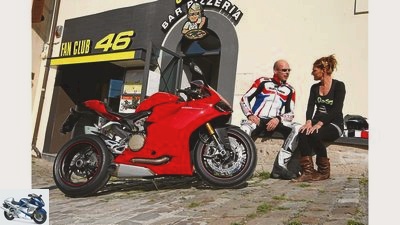
15/15
The Panigale was a welcome guest in front of the official Rossi fan club in Tavullia.
Top test Ducati 1199 Panigale
The strongest production two-cylinder in the test
The advance laurels were great, the expectations are high. Now the Ducati Panigale, the strongest and lightest production two-cylinder of all time, has to show its colors.
Two minutes. At most. It doesn’t take any longer, then the Ducati Panigale is surrounded by a crowd of people on the village square in Tavullia, Valentino Rossi’s hometown.
She is admired like a UFO. From Rossi and Biaggi fans, Ducati, Aprilia and Yamaha fans, Desmosedici drivers, pensioners, women and fathers with prams. “Hey Tino, look, an Aprilia from Ducati,” jokes someone, pointing to the slim Ducati rear. Much enemy much ore.
With the Panigale, Ducati is practically reinventing itself. 90-degree V2, single-sided swing and desmodromic remain. But with it, the era of tubular trusses ends. The engine now plays a major role as a “fully stressed member”. It carries a swing arm, suspension strut deflection and a monocoque made of cast aluminum, more rudiment of the frame than the chassis, which connects the steering head with the motor. A brave concept. Radical but necessary to push the weight down. The scale reports 194 kilograms, including ABS. Class record.
“Unheard of”, some traditionalists may still complain. But didn’t they also do that when toothed belts replaced the vertical shafts? So now chain instead of toothed belt, plain bearings instead of roller bearings for the crankshaft and monocoque instead of tubular space. Plus ride-by-wire instead of throttle cable for the throttle valves. It remains to be seen whether this is real progress.
The Italians in Tavullia want to know everything exactly. How hard, how fast, how strong? And how does it drive? Well, friends, we would like to know that too – that’s why we take enough photos. Kombi, ritsch, closed, helmet on, ciao amici.
D.he pressure on the starter conjures a benevolent grin on the faces of the bystanders. Not because the small, light starter, powered by a small, light battery, struggles as it always has despite the automatic decompression. The loud bass, the pressure waves that blatantly escape the two exhaust stubs under the engine make your eyes wander uncertainly under the engine. Is there a racing exhaust sitting there? Tolerant neighbors are definitely not a disadvantage, and so are ear plugs in the long run. How does something like that take the approval hurdles? Probably only with sophisticated control of the exhaust flap. The engine mixes the dust-dry, loud drumming with a hard mechanical hammering and a quiet buzzing, timing chains and above all the plastic gears of the huge water pump send their regards. The Panigale is not a quiet step.
Buy complete article
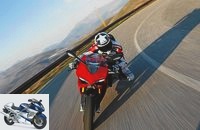
Top test Ducati 1199 Panigale
The strongest production two-cylinder in the test
Ducati 1199 Panigale S Wheelie.
Not only the two spark plugs, but also each of the four injection nozzles are individually regulated depending on exhaust gas values, air and engine temperature and the air pressure in the intake duct. Nevertheless, wishes remain open. When coordinating ride-by-wire and responsiveness, for example. If the throttle valves are opened quickly, especially from lower engine speeds or after rolling phases, the power input is sometimes slightly delayed and in bursts. Annoying especially in city traffic and on narrow streets. You can feel that the ride-by-wire and not the driver’s hand controls the throttle valve. But because this is by far not as pronounced as with the MV Agusta F3, you can come to terms with it. And then the Panigale really rocks the corner swing.
Because it whips smoothly through the curves like no Duc before, still delivers that inimitable Ducati blow, because it bravely breaks new ground. A piece of technical avant-garde. Nicely done, with great details. That has always made the Ducatis so attractive, that they consistently bring racing development onto the road – if necessary without regard to suitability for everyday use. After all: the insect-sensor-like mirrors allow more consideration than with the 1198, and the LED light, which was used for the first time on a motorcycle, creates a neat swath in the night.
On the other hand, 6.1 liters consumption is not a brilliant achievement, and the manifold under the seat heats up the thighs quite tremendously when driving slowly. At the latest when the throttle valves are on draft, the V2 enters the upper half of the speed range, that is forgotten. Because then the Ducati is in its element, everything fits, the V2 hangs tightly on the gas, releases more power as desired when the throttle valve is opened a little. Even if you quickly find yourself in speed regions that belong better on the racetrack. And where their talents are sure to come into their own. She gave a foretaste of that 14 days ago at the first run of the Superstock World Championship: pole position and third place. Strong debut.
MOTORCYCLE points evaluation / conclusion
The Panigale enables front wheel dancing, especially in race mode, but this also results in very short braking distances.
engine
The smooth-running twin clearly has its strengths in the upper speed range. Overall, however, this is not enough, especially since the response behavior thwarted any liveliness in the lower speed range due to the ride-by-wire that is not yet optimally coordinated. The V2 holds back with vibrations, but is very loud. The slipper clutch is smooth and easy to dose, and the newly designed gearbox is pleasing. The V2 did not always start immediately, sometimes it emitted a powerful cloud of smoke when it started.
landing gear
The absolute highlight of the Panigale, even if the hard-tuned shock absorber is at war with short, hard impacts, which leaves little room for comfort. Impeccable handiness, squeaky clean turning, plus dignified stability in an inclined position, this is how Ducati driving becomes a pleasure. And the neatly coordinated fork reconciles the hardness at the rear. At top speed there is a slight restlessness, which was already indicated during the presentation on the race track in Abu Dhabi.
everyday life
When was the last time you could certify a Ducati athlete with absolutely successful ergonomics? The seating arrangement is absolutely convincing from a sporting point of view. The wind protection is a bit better than on the 1198. The white LED headlights do their job properly. The outriggers of the mirrors are now long enough, but they vibrate vigorously. The relatively small 17-liter tank only allows an average range in view of the high consumption.
security
ABS is now acceptable to athletes. In the Panigale, it ensures short to very short braking distances, depending on the mode. Then, however, with an increased tendency to stubble. The Panigale brake has lost the brutal bite of older systems, which gives it excellent controllability. Absolutely within the framework: the low erection moment.
costs
Nobody will expect top marks here. Over 190 hp and the 200 rear tire just eat up your wallet. Commendable: 12000 maintenance intervals, but long inspection times.
Price-performance
The fact that a premium athlete in this price range is not a bargain is also reflected in the price-performance rating.
| Max points | Ducati 1199 Panigale S. | engine | 250 | 192 |
| landing gear | 250 | 193 | everyday life | 250 | 125 |
| security | 150 | 113 | costs | 100 | 49 | Overall rating | 1000 | 672 | Price-performance note | 1.0 | 4.0 |
Conclusion
No, the Panigale is not perfect, the draft is disappointing. And yet it is a milestone. Huge peak performance, revving, wide speed range, useful electronic helpers. In addition, a manoeuvrable chassis and, despite the new chassis concept, lots of the typical Ducati feeling. She is the Beauty Queen anyway. But if it is not yet fully developed, the ride-by-wire coordination and the power delivery need to be improved, at least for use on country roads.
Technical data / noticed
The Panigale was a welcome guest in front of the official Rossi fan club in Tavullia.
engine
Water-cooled two-cylinder four-stroke 90 degree V engine, two overhead, chain-driven camshafts each, four valves per cylinder, desmodromic actuation, wet sump lubrication, injection, Ø 68 mm, regulated catalytic converter, 440 W alternator, 12 V / 6 Ah battery, Hydraulically operated multi-disc oil bath clutch (anti-hopping), six-speed gearbox, O-ring chain, secondary ratio 39:15.
Bore x stroke 112.0 x 60.8 mm
Displacement 1198 cc
Compression ratio 12.5: 1
rated capacity 143.0 kW (195 hp) at 10750 rpm
Max. Torquest 132 Nm at 9000 rpm
landing gear
Monocoque made of aluminum, upside-down fork, Ø 50 mm, adjustable spring base, electrically adjustable rebound and compression damping, hydraulic steering damper, single-sided swing arm made of aluminum, central spring strut, lying, with lever system, adjustable spring base, electrically adjustable rebound and compression damping, double disc brake at the front , Ø 330 mm, four-piston fixed calipers, rear disc brake, Ø 245 mm, two-piston fixed calipers, ABS, traction control.
Cast aluminum wheels 3.50 x 17; 6.00 x 17
tires 120/70 ZR 17; 200/55 ZR 17
Tires in the test Pirelli Supercorsa SP
Dimensions + weights
Wheelbase 1437 mm, steering head angle 65.5 degrees, caster 100 mm, spring travel f / h 120/130 mm, permissible total weight 370 kg, tank capacity / reserve 17.0 / 2.0 liters.
Service data
Service intervals 12,000 km
Oil and filter change every 12,000 km 3.5 l
Shell Advance Ultra 4 SAE 15W50 engine oil
Telescopic fork oil Ohlins viscosity 19.0 c ST /
Shell Advance Fork SAE
Spark plugs NGK MAR9A-J
Idle speed 1500 ± 100 / min
Two year guarantee
One year mobility guarantee
Red color
price 24 490 euros
Price test motorcycle 24 490 euros
Additional costs around 305 euros
Noticed
positive
- The steering angle allows an acceptable turning circle.
- The TFT display is very easy to read in the dark by switching to light text on a dark background.
- Despite the diverse functions that the electronics provide, the menu navigation is simple and clear.
negative
- The line of elbows of the standing cylinder heats up the thighs strongly, especially uncomfortable in the city.
- The side stand is difficult to reach with the heel.
- The glass of the TFT display is highly reflective and very sensitive to scratches.
Related articles
-
Ducati 1199 Panigale S already driven
Manufacturer 15 pictures 1/15 Grim look: LED headlights are being used for the first time in a motorcycle. 2/15 Ducati 1199 …
-
Ducati 899 Panigale in the driving report
Cervetti 17th photos Ducati 1/17 Even with the front wheel still braked and at high speed, the Ducati 899 Panigale hits the path precisely into the…
-
Comparison test Ducati 916 Biposto, Honda CBR 900 RR and Triumph Daytona T 595
Comparison test Ducati 916 Biposto, Honda CBR 900 RR and Triumph Daytona T 595 Fire and flame It had to be that way. Everyone wrote it, everyone …
-
Ducati 1199 Panigale S – The new super sports car
Ducati Driving report: Ducati 1199 Panigale S The new super sports car from Ducati Your task is clearly defined: be fast on the racetrack. For this…
-
Ducati 1199 Panigale, EBR 1190 RX and KTM 1190 RC8 R.
Jahn 32 pictures Jahn 1/32 Cloud-free sky, glorious sunshine, the rumble of thunder: Three mighty V2 superbikes race down the slopes of Oschersleben …
-
Ducati Monster 1200 S in the top test
www. 33 Pictures 1/33 2/33 Noticeable negative: When folding up the tank gets stuck at the front, so the …
-
Ducati 899 Panigale and Ducati 1199 Panigale in the test
www. 23 photos 1/23 4200 euros, 47 hp, three kilograms – in order of importance, these are the most striking differences between…
-
Bilski 15th photos Bilski 1/15 Despite nominally just 131 PS the Ducati has significantly more thrust than one might expect. Bilski 2/15 For everyday…
-
BMW HP4 and Ducati 1199 Panigale R in the test
49 photos 1/49 Exceptional in terms of performance and chassis: Ducati Panigale R and BMW HP4 in the test. 2/49…
-
Ducati 999 S and Ducati 1199 Panigale S in comparison test
fact 14th photos fact 1/14 The rattling through the city with the Ducati 999 S is deep in the memory. But honestly, the current Ducati Panigale with the…